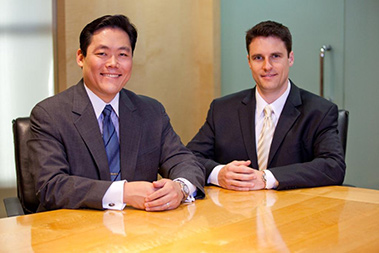 Top 10 Ways Courthouse Budget Cuts Burden LA Attorneys
Top 10 Ways Courthouse Budget Cuts Burden LA Attorneys
By H. Han Pai, Esq., Salisian | Lee LLP

For the past several years, statewide, court-related budget cuts have taken a toll on California's court system. Those cuts are now hitting home with practical consequences, as a Court Consolidation Plan was implemented in phases in the Los Angeles County courts beginning in March 2013.
The following highlights some of the major changes that could, if they have not already, lead to higher costs and bigger burdens for litigators throughout Southern California as a result of the Consolidation Plan.
- "Personal Injury" Cases - Location of New Cases
- Effective March 1, 2014, all new "personal injury" cases, defined by Local Rule 2.3(a)(1)(A), must be filed at one of two locations: (1) the Stanley Mosk Courthouse in downtown Los Angeles, which now houses four Personal Injury Departments, or (2) the Antelope Valley Courthouse (North District) in Lancaster, California. The Filing Court Locator on the Los Angeles County Superior Court's website determines the filing location.
- The personal injury case consolidation first took effect on March 18, 2013, which resulted in existing cases filed in courthouses other than Stanley Mosk being transferred there, and then randomly assigned to one of three PI Departments.
- The Personal Injury Courts have their own General Orders applicable only to these Courts, available on the Los Angeles County Superior Court website. The most recent General Orders are dated July 10, 2013 and July 19, 2013.
- "Personal Injury" Cases - Transfer of Existing Cases
- Effective April 1, 2014, all general jurisdiction Personal Injury cases that were previously transferred in 2013 from the Antelope Valley Courthouse to the Stanley Mosk Courthouse will be transferred back to the Antelope Valley Courthouse. Any existing court dates will remain set on the dates previously noticed, unless otherwise ordered by the court.
- Also effective April 1, 2014, all general jurisdiction Personal Injury cases filed in the Stanley Mosk Courthouse between March 18, 2013 and February 28, 2014, that can be identified as Antelope Valley cases will be transferred to the Antelope Valley Courthouse. Existing court dates will remain set on the dates previously noticed, unless otherwise ordered by the court.
- "Personal Injury" Cases - Law and Motion Court Reservation System
- On June 10, 2013, a pilot program for law and motion calendaring launched for Personal Injury departments. The program, for Personal Injury cases only, is called the Court Reservation System (CRS), and requires parties to reserve court hearings online for nearly all types of motions, except motions to compel further discovery responses. Such motions to compel require the parties to first participate in an informal discovery conference ("IDC") with the judge as a condition to filing the motion. IDCs are recommended, but not required, for all other discovery disputes.
- This requirement essentially forces parties to incorporate the IDC into the meet-and-confer process - certainly no easy feat with only a typical 45-day initial window for such motions.
- "Personal Injury" Cases - Trial
- The Personal Injury departments do not conduct jury trials, and the Judges are assigned only for pre-trial purposes. On the trial date, Department 1 in the Stanley Mosk Courthouse, a master calendar department, reassigns the case to one of thirty-one dedicated Trial Courts located throughout LA County. So unlike most other cases, even if a pre-trial judge was favorable (or not) to one side throughout the pendency of the case, that judge is no longer presiding over the case for trial.
- "Personal Injury" Cases - C.C.P. § 170.6 Challenges
- Having only three judges in the available pool for Personal Injury cases at the Stanley Mosk Courthouse severely limits the practical effect of challenges under Code of Civil Procedure section 170.6.
- A further wrinkle on CCP 170.6 challenges occurs if the case proceeds to trial, which would then be subject to rules for master calendar cases. Of note on the Personal Injury Court's own Frequently Asked Questions posted on the LASC Court website is that Department One announces the identity of the judge and the location of the Trial Court where it will be transferred "twenty minutes before the transfer takes effect. This procedure gives the parties and counsel 20 minutes to determine whether to file a written motion to disqualify the trial judge under C.C.P. § 170.6. . . ."
- Limited "Collections" and "Non-Collections" Cases - Location of New Cases
- The changes do not stop at Personal Injury actions. Effective March 18, 2013, all limited jurisdiction "collections cases", defined by Local Rule 2.3(a)(2)(A) must be filed in one of two courthouses, Chatsworth or Norwalk, depending on the zip code.
- All limited jurisdiction non-collections cases must be filed at the downtown Stanley Mosk Courthouse.
- Like the Personal Injury Courts, the Limited Non-Collections Courts also their own General Orders applicable only to these Courts, and available on the LASC court website. The most recent General Orders are dated February 7, 2013 and March 13, 2013.
- For Limited Non-Collections cases filed downtown, it appears that there is only one department handling all pre-trial motions - Department 77 - effectively eviscerating CCP 170.6 challenges for these matters.
- Limited "Collections" and "Non-Collections" Cases - Location of New Cases
- Also effective March 18, 2013, all limited unlawful detainer cases must be filed in one of five regional hub courthouses, Stanley Mosk, Pasadena, Long Beach, Santa Monica, and Antelope Valley, depending on zip code.
- Like the Personal Injury Courts, the Limited Unlawful Detainer Courts also their own General Orders applicable only to these Courts, and available on the LASC court website. The most recent General Orders applicable to Cases Assigned to a Hub Location and those assigned to the Stanley Mosk Courthouse are both dated July 23, 2013.
- Personal Injury and Limited Cases - exemption from Case Management Rules
- One procedure that applies across the board to all Personal Injury and limited cases is the exemption from the case management rules (California Rules of Court 3.720, et seq.). This set of rules typically governs case management of all cases, which includes trial setting, referrals to alternative dispute resolution processes, among others.
- Elimination of Alternative Dispute Resolution Program
- Effective March 11, 2013, the entire Alternative Dispute Resolution program in the Los Angeles County Superior Court system was eliminated. Accordingly, the ADR departments will no longer accept referrals for Party Select and Random Select (Pro Bono) Panels and for arbitrations, mediations, neutral evaluations, and voluntarily settlement conferences from civil, family, and probate courtrooms.
- This ADR program was previously a viable choice for cost-conscious litigants looking to resolve their disputes outside of the courtroom at a discount. With the elimination of this program, parties may very well turn to private ADR services that could be more convenient for all involved and likely more efficient than the court system. Cost is certainly a concern, but the market may adjust based on demand. Cost made ADR less favorable in recent years, but that tide is shifting back.
- Elimination of Court Reporters
- Effective June 14, 2013, court reporters, which were previously available on select days and times at courthouses within Los Angeles County (a short-lived budget cut itself), will only be available in the Writs and Receivers Department (departments 82, 85, and 86) at the downtown Stanley Mosk Courthouse.
- The expense for a transcript has thus increased ten-fold in some circumstances. Litigants now need to bring their own court reporter if they need a hearing on the record, or hire one from CCROLA, the court-reporting agency formed by the court reporters laid-off from the Los Angeles County Superior Court in the aftermath of the budget cuts.
Inevitably, these changes mean that potential litigants and the attorneys counseling them need to think longer and harder whether to bring suit, or whether a matter can be instead be brought in Federal Court, or another county in California that has not suffered similar cuts. Now, citizens of the County can only vindicate their rights in specified locations, depending on the case. And the road to that vindication has become longer, more complicated, and of course, much more expensive.
This is only the beginning of the budget crisis story for Los Angeles County courts, as news of refinements or modification to existing policies are regularly making headlines. Unfortunately, the lack of resources in an area in desperate need of them is quickly becoming the norm.
 The Impact of New CEC Regulations on Commercial Real Estate in California
The Impact of New CEC Regulations on Commercial Real Estate in California
By Jay Lichter, Esq., Salisian | Lee LLP

California's new regulations that help promote environmentally conscious practices in commercial real estate transactions may have a significant effect on future contract terms and create potential new sources of civil liability.
Adopted by the California Energy Commission (CEC), these "green" regulations are the result of a process that can be traced back to 2007, when the California Legislature enacted AB 1103. AB 1103 reflected an EPA policy that improving energy efficiency in buildings is the fastest, cheapest, and largest untapped solution for saving energy, saving money, and preventing greenhouse gas emissions.
The new regulations require nonresidential building owners to benchmark and disclose the energy usage of their buildings before entering into major financial transactions involving those buildings. "Energy usage" encompasses a building's consumption of all types of energy, including electricity, natural gas, fuel oil, and district steam.
The new regulations establish a benchmarking system that makes energy consumption information for all nonresidential buildings in the state readily accessible. This new system allows building owners and operators to compare their building's performance to that of similar buildings and to manage their building's energy cost.
The comparisons are expected to motivate building operators to take actions to improve a building's energy use and help justify the cost of those improvements. These provisions were formally adopted in October 2013 as the Nonresidential Building Energy Use Disclosure Program. The regulations are now being phased into effect.
Under the Nonresidential Building Energy Use Disclosure Program, nonresidential building owners will be required to disclose a building's energy use over the past 12 months to prospective buyers, lessees, and lenders. The regulations also require owners to benchmark that data by providing a comparison of the building's energy use to that of similar buildings.
As a result, these requirements may give rise to disputes as to the program's implicit incentives to reduce energy usage levels. For example, landlords may want to incorporate language in leases allowing them to limit, if not outright control, the energy usage of their tenants. These provisions may allow for such measures as automatic power shutoff after regular business hours, limits on the use of temperature controls, and restrictions on the use of equipment that consumes large amounts of energy.
Since these regulations are relatively new, they also present questions concerning enforcement and the potential for litigation. Significantly, the statutes implementing these regulations do not provide the CEC with the authority to impose monetary or other penalties for noncompliance.
The absence of any specific enforcement mechanism, however, by no means suggests a lack of other legal means of achieving the policy objectives for which the regulations were enacted.
For instance, failure to disclose knowledge of the building's energy usage could constitute a cause of action in a civil suit. If an owner fails to disclose the required information, a buyer, lessee, or financier of a commercial property may have a viable claim for negligent misrepresentation, fraud, or a violation of California's Unfair Competition Law.
The legal and technical burdens imposed by California's new energy disclosure laws are significant. Attorneys with clients who own commercial real estate should learn about these new regulations in order to offer proper advice on compliance. California's continuing advancement toward a greener future also gives attorneys an opportunity to help reduce energy waste and promote higher energy efficiency.
 AB 1183 - Working to Curb Discovery Abuse
AB 1183 - Working to Curb Discovery Abuse
By H. Han Pai, Esq., Salisian | Lee LLP

The Civil Discovery Act, the statutory body governing discovery procedures for California civil actions, has long been a source of headaches for many civil practitioners, largely because the Act has left it to the parties to conduct discovery on an honor system. The gamesmanship and abuse that arise from such a system is not difficult to imagine.
The Legislature has taken a step, albeit a small one, to curb such abuse with the passage of Assembly Bill ("AB") 1183, which was approved by the Governor and chaptered with the Secretary of State on June 24, 2013.
AB 1183 impacts one of the most commonly-filed discovery motions in civil litigation – motions to compel further discovery responses. A litigant requesting discovery in the form of interrogatories, requests for production of documents, or requests for admissions, may file a motion compelling further responses under specified circumstances. Under prior law, that motion must be made within 45 days of service of the responses, or that right is waived. This bill makes a subtle and seemingly minute addition to clarify an ambiguity in the prior law by amending it such that the 45-day period begins to run after service of verified responses.
Prior law did not explicitly state that the 45-day deadline ran from service of the "verified" response, thus an ambiguity existed as to whether the clock starts from service of any response. Many practitioners follow case law holding that unsworn responses are tantamount to no response at all, see Appleton v. Superior Court, 206 Cal. App. 3d 632, 636 (1988), and already treat the deadline as being triggered only on service of the verified responses. Yet, that ambiguity allowed for the argument that the deadline was triggered on service of any response, whether verified or not. Proponents of the bill contend that this addition will "help decrease abuses of the discovery process" and give "clear guidance to both parties in civil litigation."
Deadlines are the bedrock, and perhaps the bane, of the civil litigator's existence. Generally speaking, more time is always better, and any law that extends the precious commodity of time is welcome. AB 1183 makes a huge impact on that commodity. If a party requesting discovery determines that the responses are deficient, that party is now not obligated to file a motion to compel until service of the verified responses. When serving discovery responses, it is very common for attorneys to serve unverified responses, with the explanation that the verifications are forthcoming. Usually, verifications are served with minimal delay, but sometimes delay ensues. With this bill, the requesting party no longer needs to worry about the 45-day deadline being triggered from service of the unverified responses, and can wait until service of the verifications.
Yet, even something intended to benefit the litigation process is not immune from creative, or perhaps unscrupulous, practitioners seeking to gain an advantage. An example is where the responding party never serves verifications, or delays so much that the other party is forced to take action. Based on Appleton, the requesting party can simply treat the unverified response as no response at all, which allows that party to move to compel based on failure to serve a timely response, which implicates issues of whether various privileges were waived. See Civ. Proc. Code §§ 2030.290; 2031.300; 2033.280.
All told, AB 1183 is step in the right direction by the Legislature to curb the often rampant discovery abuses facing civil litigants on a day-to-day basis. At least for discovery motions, this bill will hopefully deter parties from engaging in any game-playing, and instead, will move them towards focusing case resolution.
Legal Disclaimer: The information contained in this newsletter is provided for informational purposes only, and should not be construed as legal advice on any subject matter. No recipients of content from this newsletter, clients or otherwise, should act or refrain from acting on the basis of any content included in the site without seeking the appropriate legal or other professional advice on the particular facts and circumstances at issue from an attorney licensed in the state of California.





